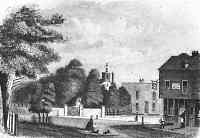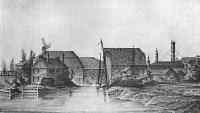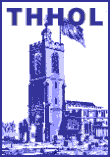Bromley has not only in the past suffered from loss of individuality, for to-day, despite the fact of the parish being a considerable area within the Borough of Poplar, it is commonly and vaguely supposed to be a small district in the vicinity of the river Lee somewhere between Bow Church and East India Dock Road. This lack of precise knowledge is partly due to the little village of Bromley that had established itself near the Priory walls having a long association with Bow, so that when, in the nineteenth century, houses were built along the adjacent northern portion of the parish, the name of its attractive neighbour was readily accepted. For convenience of postal service it was included in Bow just as for the same reason the southern part of the parish was placed in Poplar. For everyday purposes the 'Saint Leonard' gradually fell into desuetude, and in its shortened form, Bromley, it became restricted to a small industrial district near by its church. In order to put an end to the confusion that had arisen between what was said to be a somewhat obscure place and the better known Bromley in Kent, it was decided to call it Bromley-by-Bow.
 The
parish consists of six hundred and six acres. It will doubtless come as a surprise to many to
[learn] that the greater part of East India Dock is within its limits, and that it has for its
northern boundary the middle of Bow Road from Coborn Road to almost as far as Bow Church, whence
it takes a southerly direction. Those who pass along the main road will scarcely fail to notice
the relative positions of old Bow Vestry Hall at the corner of Fairfield Road and, nearly opposite,
old Bromley Vestry Hall.
The
parish consists of six hundred and six acres. It will doubtless come as a surprise to many to
[learn] that the greater part of East India Dock is within its limits, and that it has for its
northern boundary the middle of Bow Road from Coborn Road to almost as far as Bow Church, whence
it takes a southerly direction. Those who pass along the main road will scarcely fail to notice
the relative positions of old Bow Vestry Hall at the corner of Fairfield Road and, nearly opposite,
old Bromley Vestry Hall.
Excepting for the village this area, less than ninety years ago, was almost unbuilt upon. It is now covered with streets whose total length amount to twenty-four miles. The population in 1801 was 1,684; and in 1881, 4,846. Fifty years later it had increased to 64,111, and last year, 1933, according to an estimate of the Ministry of Health, there were 59,436 inhabitants.
 Unlike
all the other parishes and hamlets between the City and the River Lee, Bromley was not formed
out of the extensive parish of Stepney. There is a locally well-known advertisement of an auction
held in 1786 at the 'Seven Stars' inn. The property offered for sale is described therein as
being in Bromley and held by copyhold of the manor of Stepney. As the property was situated
on the north side of High Street it was actually in Bow.
Unlike
all the other parishes and hamlets between the City and the River Lee, Bromley was not formed
out of the extensive parish of Stepney. There is a locally well-known advertisement of an auction
held in 1786 at the 'Seven Stars' inn. The property offered for sale is described therein as
being in Bromley and held by copyhold of the manor of Stepney. As the property was situated
on the north side of High Street it was actually in Bow.
In ancient deeds the territory that constituted this manor is referred to as Brambeley. It appears to have been not long after the Norman Conquest vested in the fee, that is the territorial unit measured not by extent but by rent or valuation, in the Earldom of Essex. One of the earliest records is a
'Grant and confirmation by Geoffrey, Earl of Essex, to Holy Trinity London, of the land of Edward de Schelgeford that Earl Geoffrey his grandfather gave them in frank almoin [a free and perpetual gift for spiritual services to be rendered] the half hide of land [about sixty acres] in Brambeley that William son of Wido gave them when he was made a canon there, and which the Earl, his father, confirmed to them ; and the remaining part of the said William's land, that Robert de Ponte had of the gift of his father and gave the canons when he was made canon, which they are to hold of the Earl by the service the said Robert did to his father. Witnesses Rahesia, the Countess, 'my mother,' Warin son of Gerold the King's Chamberlain, Henry the son of Gerold and others named' (A.D. 1144- 1165).
During the reign of Richard I the manor was held by Ralph Triket or Trichet, the King's Chamberlain. He granted to Robert de Ponte [of the bridge, i.e. Bow] certain lands in Brambeley described as Northmede, Sparweharn, Wilda, and
'the dwelling house of Hugh son of Baldwin, and Wigewich, and Edmund's land for half a mare yearly. This also Hugh his son has granted, and Armigarde his wife; and for this grant Robert has given to Ralph six mares of silver, and to Hugh his son a many coloured mantle and a green fustian towards making him a knight, and to Armigarde his wife a gold 'manca' [a square gold coin] and in addition to the above half mare, to three acres of meadow and a 'morsel' of land, Robert has accommodated Ralph with 30s., and as long as the 30s. are owing the former will be quit of paying the half mare.'
Among the other deeds of the twelfth century there are two executed by Ida, the granddaughter of Ralph Triket, after she became a widow. It was a necessity imposed by feudal law in cases of land being held by the King by knight service that the holder should be a man capable of bearing arms to perform the service due in respect of the same. A grant of land made by a woman in these circumstances did not cause her to thereby suffer equitable loss but for the time being there was someone who could be accounted legally the tenant and be called upon by the King to fulfil the obligation. In both deeds allusions to the manorial court of Brambeley are made, and in the following its position is indicated:-
'Grant by Ida, daughter of Hugh Triket, late wife of Roger de Pirou, after the latter's death, to Ralph, son of Yvo de Londonis, of the lands of her fee of Brambeley that Wlfurn de Rocholt [Ruckholt], Aluric son of Salona and Theobald son of Yvo held, paying yearly 2 lbs. of wax ; and of an acre on the hill before her court of Brambeley, paying 1d. yearly. She has sworn to observe this grant 3 Sept. 4. Richard 1 [1292] on which day she received the homage of the said Ralph.'
The manor continued in the Triket family for many years. It was stated that in the year 1272, when Edward I was crowned, Idonea Triket held certain lands here by service of holding the king's napkin at the coronation. The value and importance of Brambeley at this period was principally on account of its position on the river Lee which gave water power to mills.
From time to time grants of land were made to the Prior and Canons of Holy Trinity, Aldgate, who, apart from the exercise of religious duties and observances, actively engaged themselves in agricultural matters as was necessary for the sustenance of their household and maintenance of their dependants. They were men capable in the administration of secular affairs, and under their direction were undertaken the tillage of land, the draining of marsh, the making and repair of river embankments, and the erection of water-mills. By the year 1292 the lordship of the manor had passed to them, and they forming a religious corporation were not liable for the feudal conditions that previously were imposed on the holding of the land in respect of military service. A glimpse of Bromley as it was in mediaeval days is obtained from a Grant
'by the prior and the convent of Holy Trinity, London, to William le Norcis, of three acres at Brambeley in the field called 'Edmunds field' all the wall with the willows south of that field, a pond and ditch, a wall by Richard Tuthaits house extending to the Lea, a wood adjoining the three acres, and the [river] wall which was the way to the old mill; saving the way that was upon the first-named [river] wall to men going to St. Leonards church and returning, for ever, and the way for horses carrying grain to the mill of the said canons, and bringing it back when necessary; paying half a mare yearly. Other covenants are specified as to repairs, making and working floodgates for millponds &c.'
The lordship of the manor was held by Holy Trinity Priory until the dissolution of religious houses in England, when it incidentally was merged with the property of the nunnery of St. Leonard, which included certain lands in the upper part of the manor. Subsequently the Crown granted out the manor with the advowson of the church and the tithes were granted out and passed into lay hands.
The parish of Bromley, that is, a district attached to its particular church and one which afterwards formed the unit of local government, was then created and styled Saint Leonard to distinguish it from other Bromleys situated elsewhere, the title being taken (for there was no church so dedicated) from the Priory and Convent which until this period had been outside Bromley at Stratford-atte-Bow. The chapel of St. Mary that had belonged to it thereupon served as a parish church without being one strictly in ecclesiastical law. This brought about a controversy between the lord of the manor, the patron of the living and the Bishop of London, which continued throughout many years before it was brought to an end. When the venerable monastic chapel, whose roof alone was in a state of decay, was pulled down in 1842, two small portions of its ancient walls were allowed to remain with the knowledge being relied on that 'a little leaven leaveneth the whole lump' and that their inclusion in the building might prevent the necessity of a new consecration, the episcopal authority being repudiated. Under this pretence of restoration a new edifice bearing the old dedication of St. Mary was erected on the site.
by Sidney Maddocks
